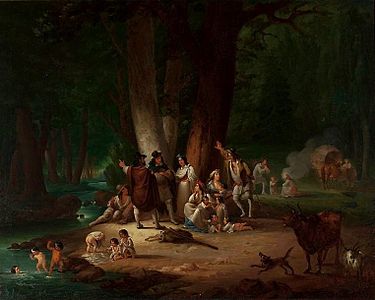You can help expand this article with text translated from the corresponding article in Lithuanian. (December 2021) Click for important translation instructions.
|

Wincenty Smokowski (Lithuanian: Vincentas Smakauskas; 19 February 1797, Vilnius — 13 February 1876, Krikonys, Ignalina Raion), was a Polish-Lithuanian painter and illustrator in the Academic and Classical styles. He created portraits, historical scenes, landscapes and genre works; notably realistic, unprejudiced portrayals of Jews and Gypsies.
Biography
From 1817 to 1822, he studied at Vilnius University where he was a pupil of the English engraver and professor of Fine Art, Joseph Saunders. From 1823 to 1829, he continued at the Imperial Academy of Arts in Saint Petersburg. He was awarded a silver medal in 1825 and a gold medal in 1827 for his version of the death of Epaminondas.
In 1829, he was invited by Jan Rustem to become an assistant professor at the university. He held that position until 1832, when the university was closed by Russian authorities.
In 1836, he graduated from the "Vilnius Medico-Surgical Academy" and worked as a doctor in the area around Švenčionys from 1841 to 1856. After two years in Warsaw, he practiced medicine from his wife's estate at Krikonys, a small village in the Ignalina region.
In addition to his paintings, he provided illustrations for Konrad Wallenrod (1828) and Pan Tadeusz (1860) by Adam Mickiewicz and the poem Anafielas [pl] (1846) by Józef Ignacy Kraszewski. He is also known for copying and helping to preserve the 15th century frescoes at Trakai Island Castle.
A street is named after him in the Pašilaičiai district of Vilnius.
Selected paintings
-
 Gypsy Encampment by a Creek
Gypsy Encampment by a Creek
-
 Stephen Bathory founding the
Stephen Bathory founding the
Vilnius Academy -
 Jewish Wedding
Jewish Wedding
-
 Entry of Bolesław the Brave into Kiev
Entry of Bolesław the Brave into Kiev
References
- "Vincentas Smakauskas". vle.lt (in Lithuanian). Retrieved 10 November 2019.
- Malinowski, Jerzy. (2010) in History of Art History in Central, Eastern and South Eastern Europe, Vol. 1. Society of Modern Art in the Department of History of Modern Art, Faculty of Fine Art, Nicolaus Copernicus University, Toruń. p, 11
- Biographical notes @ Biografiya.ru
- Biographical notes @ DESA Unicum.
- ^ Biographical notes @ Lithuanian Art Museum.
Further reading
- Olga Reichenstein-Mehlerowa, Wincenty Smokowski, Salesian School of Crafts, 1936
External links
![]() Media related to Wincenty Smokowski at Wikimedia Commons
Media related to Wincenty Smokowski at Wikimedia Commons
- 1797 births
- 1876 deaths
- 19th-century Polish painters
- 19th-century Polish male artists
- History painters
- Genre painters
- Polish portrait painters
- Artists from Vilnius
- Polish illustrators
- Lithuanian people of Polish descent
- Lithuanian painters
- Polish male painters
- Painters from the Russian Empire
- Illustrators from the Russian Empire